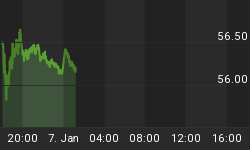Below is an extract from a commentary posted at Overview A short-term bottom was probably put in place in the stock market at the end of last week and the market will probably rebound sufficiently over the next 2-3 weeks to take the S&P500 Index to a new high for the year. However, we currently have something akin to a "Pascal's Wager" situation in that the positive consequences of betting on a short-term bullish outcome and being right are far less than the negative consequences of betting on a short-term bullish outcome and being wrong. In other words, although the market will PROBABLY move several percentage points higher in the short-term the alternative is that the rebound high from the March low is already in place and a major decline is in its early stages. This is why we have just added a second position in USPIX (a leveraged inverse index fund) to the Stocks List. Our plan is to add another bearish speculation to the List (a third position in USPIX or, perhaps, some put options) if the market rallies over the next few weeks and negative divergences continue. Current Market Situation The bond market stabilised during the second half of last week and this had the predictable effect of causing a sharp rebound in the NYSE Advance-Decline Line (due to the large number of interest-rate sensitive stocks on the NYSE) and modest strength in the senior stock indices. However, the price action during the second half of last week was not at all bullish and, as illustrated by the below charts, has left the market 'on the edge'. Below is a chart of our old favourite -- the NDX/Dow ratio. NDX/Dow is a measure of the willingness of market participants to take-on risk. This ratio has not only tended to trend with the overall market over the past few years, it has also led the market at important turning points. Note that NDX/Dow peaked in January, bottomed in March, and was in the process of rebounding prior to a sharp drop during the second half of last week. It is still comfortably above its March low, but continuing weakness in this ratio in the short-term would be evidence that a major decline is either already underway or about to begin. We'll now take a look at the SOX/NDX ratio. This ratio provides similar information to the NDX/Dow ratio in that the semiconductor stocks (represented by the SOX) have greater valuation risk than the average large-cap tech stock (represented by the NDX). Therefore, when the SOX/NDX ratio is moving higher it is evidence that market participants are prepared to throw caution to the wind. A general willingness to ignore valuation risk is, in turn, critical if a dramatically over-valued market is going to move even higher.
Note that SOX/NDX turned down at the beginning of December and after rebounding for a couple of weeks has just dropped back to near its recent low. Further weakness from this point in the semiconductor stocks relative to the NDX would be a significant negative for the overall market.

Next, below are charts of two of the leading semiconductor stocks: Applied Materials (AMAT) and Intel (INTC). Both stocks ended last week near important support, so either they are about to rally or the rebound from the March bottom is over.


Lastly, the below chart of Alcoa (AA), the world's largest aluminium producer, has just tested support at 32.50 for the third time this year. A close below 32.50 would create a technical target of around $26, a level at which we would probably be buyers of the stock.

As mentioned above under "Overview", we think the odds favour support holding and the market rallying in the short-term. However, the situation is dicey to say the least.
Inflation update
Alfred Broaddus, President of the Richmond Federal Reserve Bank, said last Friday that he was not "unduly concerned" inflation would suddenly surge, saying there was still a lot of slack in the economy. He also said: "It now looks like the recovery, while not galloping away, is finally gaining more momentum," and "The outlook is relatively bright".
The constant attempts by the Fed to assure us that everything is fine on the inflation front would be comedic if the situation weren't so fraught with danger. What we have is a massive US inflation problem with US policy-makers trying to 'fix' the problem by simultaneously creating a) more inflation and b) a smoke screen to conceal the effects of inflation. This is going to end very badly, but the goal is clearly to postpone the end for as long as possible in the hope that the problem will either miraculously right itself or, at worst, become the responsibility of a future set of policy-makers.
One of the ways of creating the aforementioned smoke screen has been to talk up the prospects of deflation from time to time or, to be more politically correct, to talk about the risk of an "unwelcome drop in inflation". What they always fail to mention, though, is that a drop in inflation can never be unwelcome unless there is already an inflation problem. This is because real economic growth and inflation are NEGATIVELY correlated, but a lengthy period of high inflation effectively puts in place a set of conditions whereby the short-term outlook will be brighter if the inflation can be continued. Brighter, that is, until the bond market wakes up to what is happening and begins to push interest rates sharply higher. At this time the political cost of allowing the inflation problem to build becomes greater than the short-term cost of doing something to address it.
Right now we appear to be at the point where the bond market is beginning to awaken to the inflation problem, but we are still probably some distance from the point where policy-makers feel pressured to take aggressive action to curb the problem.















